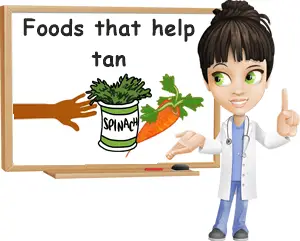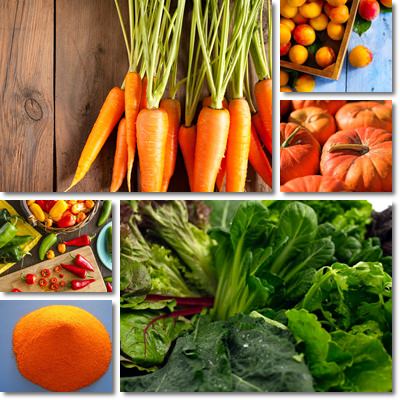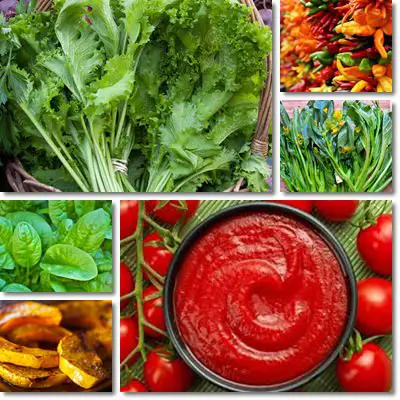When done correctly, sun exposure can be a wonderful thing for us, initiating the production of vitamin D, a much needed nutrient of crucial importance for our health.
Tan skin is the visible result of sun exposure and an indicator of good health. But sometimes, getting our skin to put on a beautiful, healthy-looking golden glow may require us to adopt rather unhealthy sunbathing behaviors which may have long-term side effects.
Fortunately, eating certain foods can help us achieve an extra tone of subtle tan as well as improve skin health and its overall appearance.
What should we eat for a healthy tan?
Foods rich in carotenes such as beta carotene, a precursor of vitamin A with strong antioxidant properties, are the most likely to help us get a beautiful tan naturally.
However, our skin needs several essential nutrients to stay healthy, regardless if it’s tanned or not, or in between. Foods rich in vitamins A, E and C, as well as healthy unsaturated fatty acids such as Omega-3 are crucial for having healthy skin to begin with. Because only healthy skin achieved through good nutrition and proper care can be safely exposed to the sun and become beautifully tan.

Eating the right foods not only ensures we have a healthy, beautiful skin, but also a healthy, beautiful tan. A high intake of carotenes (orange and red pigments in food) may cause our skin to take on a more or less pronounced orange pigment, a benign, thus harmless and perfectly reversible condition known as carotenosis or carotenoderma.
As a result, eating one or two extra servings of foods rich in carotenes can encourage a beautiful, natural, subtle tan and even offer slightly more protection against radiation from the sun as a result of the strong antioxidant properties of carotenes such as beta-carotene.
But orange and red foods are not the only ones to contain significant amounts of carotene. Dark green fruits and vegetables such as leafy green vegetables are also important dietary sources of carotenes, but also several dark purple produce varieties.
Just as important, cooking fruits and vegetables rich in carotenes, particularly beta-carotene, can make the pigment more bioavailable, meaning we absorb more of it and enjoy more of its health benefits.
20 Foods for tanning
The top 20 foods richest in beta-carotene we could consider eating when looking to tan are:
1) Apricots.
Raw apricots have about 1696 mcg (micrograms) of beta-carotene per 1 cup of 155 g of halved fruits. Dried, uncooked apricots have about 2812 mcg per cup of an estimated 130 g. Uncooked, dried peaches contain about the same amounts: 1718 mcg per 160 g cup.
2) Carrots. Canned carrot juice contains about 21955 mcg of beta-carotene per 236 g cup, while 128 g of chopped raw carrots have about 10605 mcg of beta-carotene. 146 g of frozen, boiled carrots provide 11971 mcg of carotenes. See different carrot colors nutrition for more information on the properties and benefits of orange, red, yellow, white and black carrots.

3) Pumpkin, pumpkin flowers and pumpkin leaves
Boiled unsalted pumpkin flowers contain around 1394 mcg of beta-carotene, an important form of carotene, for every 134 g. Boiled, unsalted pumpkin leaves contain 682 mcg per cup (71 g). Canned pumpkin has 17003 mcg per 1 cup of 245 g. Boiled pumpkin provides 5135 mcg per 245 g cup. See benefits of pumpkin
4) Red and green bell peppers
Sweet raw red peppers contain 2420 mcg of beta-carotene per 149 g. Boiled sweet red peppers have 2059 mcg for every 135 g.
Raw green hot peppers have 302 mcg of beta-carotene per 45 g pepper. Raw red hot peppers have 240 mcg per 45 g pepper. Jalapeno peppers: 505 mcg per 90 g cup. Nevertheless, it may be best to avoid peppers if you have acid reflux disease.
See what foods to eat and to avoid for acid reflux.
5) Squash
Boiled unsalted squash generally has an estimated of 229 mcg of beta-carotene per 180 g serving. Baked butternuts squash has 9368 mcg of beta-carotene per 205 g serving. Baked hubbard squash, a variety of winter squash, has 7339 mcg per 205 g serving. Overall, baked squash is a great source of carotenes and ideal to help our skin take on a beautiful, golden glow.
6) Sweet potatoes
Canned sweet potatoes provide us with 13308 mcg of beta-carotene per a 255 g cup. However, baked sweet potatoes with skin contain an estimated of 23018 mcg of beta-carotene for every 200 g. A cup of mashed, boiled sweet potatoes (328 g) has around 30976 mcg of the carotene. Overall, sweet potatoes rank high on the most wanted foods for tanning list.
7) Tomato sauces and green tomatoes
Canned tomato juice has around 656 mcg of beta-carotene per 243 g serving. Raw green tomatoes have 623 mcg per 1 cup of 180 g, while cooked red ripe tomatoes 703 mcg per 240 g. Just as with the lycopene in tomatoes, carotenes and beta-carotene in particular become more bioavailable when cooked. Also, it has been suggested that lycopene may have a similar, but less pronounced effect of skin pigmentation as carotenes.
8) Beet greens
Cooked, boiled and drained beet greens boast 6610 mcg of beta-carotene per 1 cup of 144 g. Both beets and their greens are one of the healthiest vegetables we can enjoy, with beets containing red antioxidant pigments with cancer preventive properties.
9) Collards
Boiled collards have 8575 micrograms of beta-carotene for every 190 g cup (chopped). Frozen, then boiled collards have 11 591 mcg per 170 g cup. Raw collards contain 5234 mcg of the carotene for every 95 g cup.
10) Dandelion greens
Raw dandelion greens have been found to contain 5220 mcg of beta-carotene per cup, while boiled dandelion greens may have anywhere from 4100 to 9100 mcg per cup. So in addition to excellent amounts of vitamin K, hepatoprotective properties and digestive benefits, dandelion greens also help us tan.
11) Kale
Boiled kale has around 10625 mcg of beta-carotene per 130 g (1 cup chopped). Frozen, then boiled kale has 11470 mcg for the same amount. Raw kale has 948 mcg per 16 g a cup. So eating one or two extra servings of kale can help us achieve the tan we dream of.
12) Lettuce
Raw butterhead lettuce: 1093 mcg of beta-carotene per 53 g (1 cup). Raw romaine lettuce: 2456 mcg per cup. Green lettuce: 1599 mcg per 36 g (1 cup). Iceberg lettuce: only 215 mcg per 1 cup of 72 g.
13) Mustard greens
Boiled mustard greens have 8820 mcg of beta-carotene per 1 cup of 140 g. For every 150 g of frozen, boiled mustard greens, we get 6369 mcg of beta-carotene. So if you are delighted with the soft texture and spicy flavor of these greens, enjoying them more often can help you get a beautiful tan naturally.
14) Parsley
Although we use it only to garnish our favorite foods, parsley is extremely nutritious, providing great amounts of iron, vitamin K and beta-carotene. Fresh parsley contains 3032 mcg of beta-carotene per cup (60 g).
15) Plums and prunes
We get 686 mcg of beta-carotene for every 174 g cup of uncooked pitted prunes. Raw plums contain about 314 mcg for every 165 g cup.
Prunes concentrate great amounts of essential nutrients, notably dietary minerals. Both plums and prunes contain powerful anthocyanin antioxidants and boast excellent laxative properties.
16) Spinach
Canned, drained spinach supplies 12585 mcg of beta-carotene for every 214 g cup. Boiled spinach 11318 mcg per 180 g cup. Frozen boiled spinach 6875 mcg per 95 g.
17) Swiss chard
Boiled Swiss chard contains about 6391 mcg of beta-carotene per 175 g. Because all green leafy vegetables are rich in vitamin K, make sure you talk to your doctor about a safe intake if you suffer from blood coagulation problems, particularly blood clotting.
18) Turnip greens
Frozen, boiled, unsalted turnip greens contain 10593 mcg of beta-carotene per 164 g. Boiled, unsalted turnip greens have 6588 mcg per 144 g cup.
19) Watercress
Raw watercress contains 651 mcg of beta-carotene for every 34 g cup and is a great option for everyone who likes healthy green leafy vegetables because of its more succulent texture.
20) Zucchini. Surprisingly, boiled summer zucchinis (without salt) provide around 1206 mcg of beta-carotene for every 180 g.

Peaches, papaya, mango, watermelon (467 mcg per 154 g) and passion-fruit, even apples, alfalfa sprouted seeds, chicory greens, boiled Chinese cabbage and raw red cabbage, boiled peas, spring onions, boiled asparagus, raw pistachios, dried spirulina seaweed are other good sources of beta-carotene and carotenes in general.
What else should I eat for a healthy, beautiful tan?
In addition to these 20 excellent sources of carotenes and beta-carotene in particular, tanning our skin requires us to also drink plenty of water to stay hydrated and keep our skin plump and healthy.
Eating healthy fats such as those in extravirgin olive oil, nuts, seeds or cocoa and chocolate can help prevent wrinkles and heal wounds and scars. Moreover, it is important to make sure we get enough of vitamins A, E and C so that when we expose our skin to the sun, it’s healthy and able to withstand the heat and radiation.
Most of the foods listed above also provide rich amounts of vitamin A and help preserve skin integrity, mucous membrane health and support good immunity (our body converts as much beta-carotene as it needs into vitamin A).
Nuts, seeds, fish and other sources of healthy fats also provide excellent amounts of vitamin E, a nutrient with wonderful emollient properties, crucial for beautiful, healthy skin.
Lastly, vitamin C ensures fast wound healing, prevents wrinkles and scarring, boasts strong antioxidant and anticancer properties.
While we can easily get our beta-carotene, vitamins A and E from dietary sources, which is best rather than risking taking too much from dietary supplements, we might not get all the vitamin C we need from the same sources.
This is because vitamin C content may vary immensely within the same variety of produce and because heat exposure as a result of cooking destroys it completely.
So while we may enjoy kiwifruit, strawberries and raw bell peppers, we might also need to meet our daily needs with the help of a natural supplement. Lastly, a healthy-looking tan skin requires sufficient and adequate sun exposure. Also see sun exposure: what is the best time for it?
Conclusion
Tanning is a process and requires a healthy skin to begin with. Orange fruits and vegetables and dark green leafy vegetables are great if we want to give our skin a boost and prepare it for sun exposure.
According to research, eating one or two extra servings of any of these foods for several weeks can help give us a healthy looking golden glow and even offer a certain level of protection to our skin when exposing it to the sun, though we will still need to use sunscreen or sunblock to avoid high risk malignancy. And considering the wide variety of produce we can choose from, eating our way towards beautiful, tan skin can be a delicious experience.
